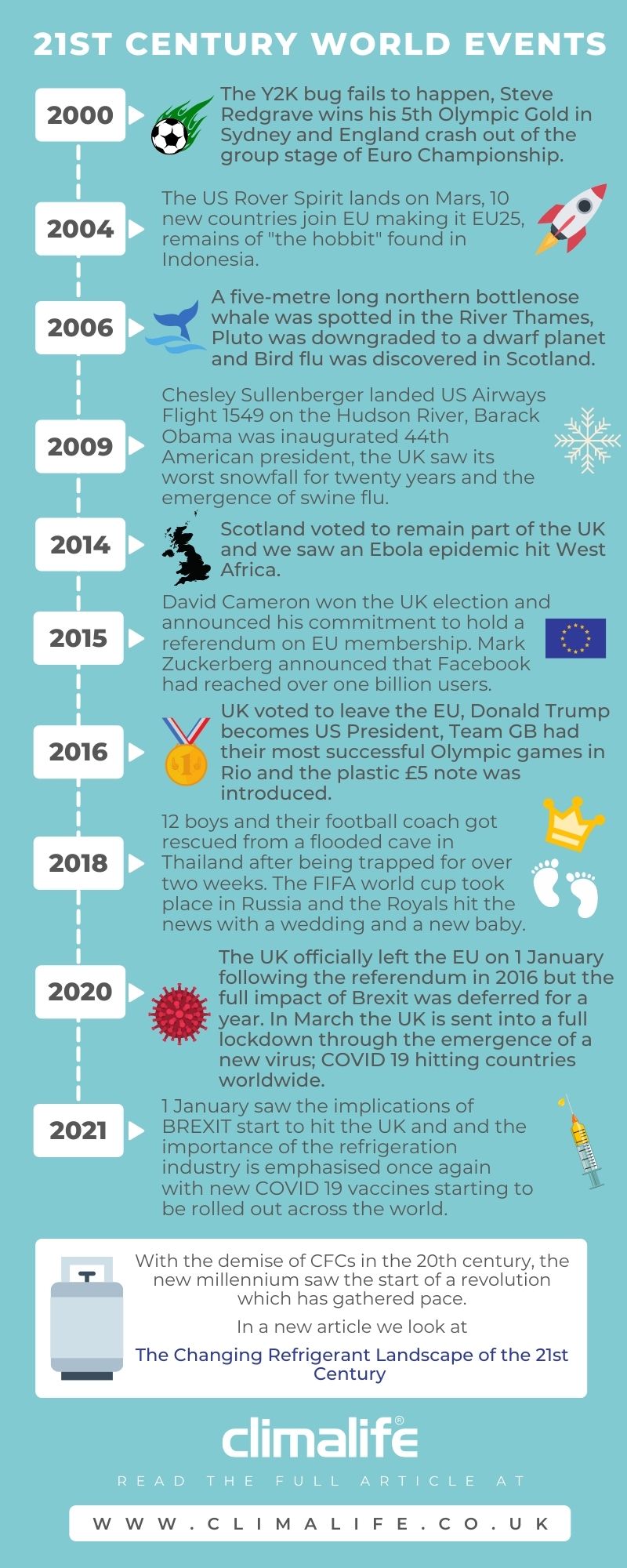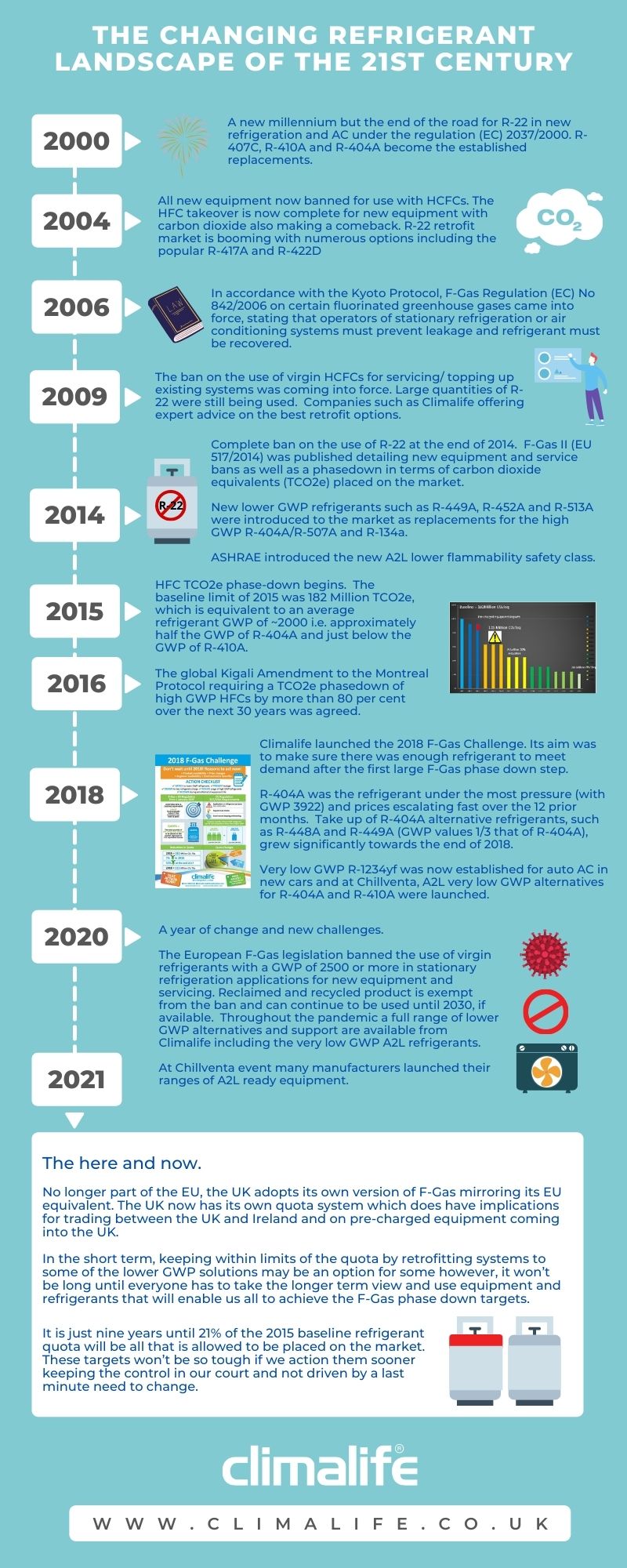The changing refrigerant landscape of the 21st Century
Climalife UK
During the 20th century the refrigeration industry witnessed the demise of CFCs and the start of a revolution which really started to gather pace with the event of the new millennium.
Click each image to expand view
Time hop back to the Y2K
A new millennium but the end of the road for R-22 in new refrigeration and AC under the regulation (EC) 2037/2000. R-407C, R-410A and R-404A become the established replacements.
2004 - The rise of the R-22 retrofit option
All new equipment now banned for use with HCFCs. The HFC takeover is now complete for new equipment with carbon dioxide also making a comeback. The R-22 retrofit market is booming with numerous options including the popular R‑417A and R-422D.
F-Gas regulation for 2006
In accordance with the Kyoto Protocol, F-Gas Regulation (EC) No 842/2006 on certain fluorinated greenhouse gases came into force, stating that operators of stationary refrigeration or air conditioning systems must prevent leakage and refrigerant must be recovered.
Moving on to 2009
The first Climalife Contact magazine was published with the headline “R-22 ban: a chilling prospect?”
The ban on the use of virgin HCFCs for servicing/ topping up existing systems was coming into force. Large quantities of R-22 were still being used. Companies such as Climalife offering expert advice on the best retrofit options.
Fast forward to January 2014
Complete ban on the use of R-22 at the end of 2014.
F-Gas II (EU 517/2014) was published detailing new equipment and service bans as well as a phasedown in terms of carbon dioxide equivalents (TCO2e) placed on the market.
New lower GWP refrigerants such as R-449A, R-452A and R-513A were introduced to the market as replacements for the high GWP R-404A/R-507A and R-134a.
ASHRAE introduced the new A2L lower flammability safety class.
2015/2016: F-Gas II legislation & Kigali amendment to the Montreal Protocol
HFC TCO2e phase-down begins – The baseline limit of 2015 was 182 Million TCO2e, which is equivalent to an average refrigerant GWP of ~2000 i.e. approximately half the GWP of R-404A and just below the GWP of R-410A.
In 2016, the global Kigali Amendment to the Montreal Protocol requiring a TCO2e phasedown of high GWP HFCs by more than 80 per cent over the next 30 years was agreed.
The 2018 F-Gas Challenge
Climalife launched the 2018 F-Gas Challenge. Its aim was to make sure there was enough refrigerant to meet demand after the first large F-Gas phase down step.
R-404A was the refrigerant under the most pressure, with its GWP of 3922 and prices escalating fast over the 12 prior months.
Take up of R-404A alternative refrigerants, such as R-448A and R-449A with GWP values 1/3 that of R-404A, grew significantly towards the end of 2018.
Very low GWP R-1234yf was now established for auto AC in new cars and at Chillventa, A2L very low GWP alternatives for R-404A and R-410A were launched.
2020 – a year of change and new challenges
The European F-Gas legislation banned the use of virgin refrigerants with a GWP of 2500 or more in stationary refrigeration applications for new equipment and servicing. Reclaimed and recycled product is exempt from the ban and can continue to be used until 2030, if available.
Throughout the pandemic a full range of lower GWP alternatives and support are available from Climalife including the very low GWP A2L refrigerants.
At the virtual Chillventa event many manufacturers launched their ranges of A2L ready equipment.
2021 - The here and now
No longer part of the EU, the UK adopts its own version of F‑Gas mirroring its EU equivalent. The UK now has its own quota system which does have implications for trading between the UK and Ireland and on pre-charged equipment coming into the UK.
In the short term, keeping within limits of the quota by retrofitting systems to some of the lower GWP solutions may be an option for some however, it won’t be long until everyone has to take the longer term view and use equipment and refrigerants that will enable us all to achieve the F-Gas phase down targets. It is just nine years until 21% of the 2015 baseline refrigerant quota will be all that is allowed to be placed on the market. These targets won’t be so tough if we action them sooner keeping the control in our court and not driven by a last minute need to change.
What has history told us?
The 21st century refrigerant landscape has seen constant changes, and when you put them into context with the headlines of the time, they really don’t seem that long ago. The refrigerant market has always met the deadlines placed upon it but at times has been slow to plan and make the change. Making changes sooner prevent unplanned downtime and higher costs by alleviating the risks of not being able to buy the products wanted at a price that is suitable.
Of course, financial barriers exist and no doubt right now this will be a consideration for many businesses, but the old adage “ a stitch in time saves nine” is very relevant as the comparison cost of low GWP options is not significantly different and ultimately those refrigerants with a higher GWP value will eventually become much more expensive that the new lower GWP refrigerants as the F-Gas quota phase down reductions continue to be applied.
The devastating consequences of COVID 19 to families and businesses has shown that not all crisis can be anticipated, but history has taught us that planning for the inevitable changes that are looming on the horizon can save money and time. Let’s listen to and learn from the advice that’s available today, change is coming and the sooner we all adopt the new solutions, the easier we make our histories of tomorrow.
We care for our customers, people, products and planet.



